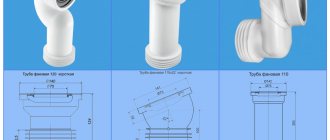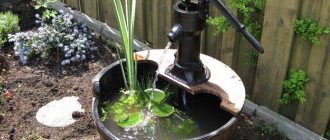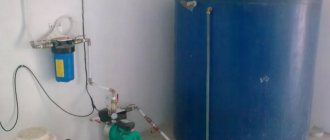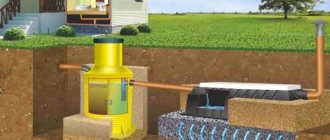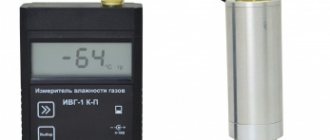Drilling a water well is a rather labor-intensive process that requires certain knowledge and skills. The article provides information that will not make you a professional driller, but will fill some knowledge gaps and help you drill a well yourself.
If you are going to drill on your own, without using special drilling equipment, then you will have access to a maximum drilling depth of about 40 meters. It will be quite difficult to drill deeper. Therefore, you have the choice of drilling a regular deep well or an Abyssinian one. It is impossible to drill an artesian well manually, since such wells are approximately 100 m deep or more.
Types of water wells
Depending on the depth of the aquifer to which the well is drilled and the features of its design, there are three main types of structures:
- Abyssinian well (the easiest way to make it yourself is due to its relatively shallow depth);
- sandy;
- artesian
The choice of type of structure depends on:
- terrain features, including the explored depth of groundwater, the nature of the soil;
- relief and built-up area - with dense buildings or small dimensions of the estate, the use of heavy drilling equipment is impossible or very difficult;
- construction budget.
The main characteristics of a well are considered (and are indicated in its technical passport when equipped by special organizations):
- aquifer level;
- the immediate depth of the well (does not necessarily coincide with the drilling depth);
- nominal diameter of the structure (determined by casing pipes);
- geological section data;
- aquifer levels (static and dynamic);
- well flow rate.
Additionally, it is advisable to know the required characteristics of pumping equipment.
A geological section in this case is a cross-section (relative to the surface of the earth) of the surface layers of sedimentary rocks indicating the depth of permeable and impervious layers and groundwater horizons. Based on the geological section data, the levels of occurrence of aquifers are indicated.
The static and dynamic levels of the aquifer are determined based on the drilling results. The first - before pumping water, the second - during active use.
For normal operation of pumping equipment, the pump is buried below the dynamic level by 5...10 m. This ensures its constant immersion even when the aquifer is depleted and water resources are being used intensively by consumers.
The flow rate (productivity) of a well is understood as the amount of water supplied to it per unit of time. Most often, flow rate is measured in cubic meters per hour (less often per minute), liters per hour, liters per minute. Performance calculations are carried out by specialists, but approximate calculations for a vertical or inclined well can be made by an amateur.
When drilling a well with your own hands, a technical passport is usually not drawn up, although this is incorrect. Records of what the aquifer level, productivity and number of inclusions in the water were at the time of commencement of operation will help determine the cause and nature of problems during further use.
Abyssinian well (well)
This type of drainage device uses the upper groundwater, while cutting off dust, dirt, and typical “overwater” contaminants that pollute the liquid. Thanks to this, the device provides cleaner water than a well.
Important: you can “pierce” a narrow well only on relatively soft soils, without rocky inclusions.
The size of the hole for installing equipment is minimal, the drilling depth is 8...12 m, the diameter is 4...6 cm. In some cases, with an aquifer of coarse-grained or medium-grained sand, a depth of 4...6 m is sufficient. The liquid enters through a filter under pressure, for better To filter groundwater and prevent clogging of the well, you can fill it with marble chips when drilling a hole.
The flow rate is 0.5...3 cubic meters per hour. For small private houses this is enough, for collection points more than 3...5 - too little. A do-it-yourself Abyssinian well is very economical, but it cannot be built on rocky soils. The reason is the insufficient penetration ability of manual drilling or low-power drilling equipment.
When installing a hand pump on the surface of the earth, this type of well is only suitable for use in the warm season. For year-round operation, installation of an automatic pump in a concreted and heat-insulated pit is required.
To drill water wells with your own hands to a shallow depth, you can do without drilling equipment, using a primitive installation for driving a casing pipe. However, in this case there is a risk of damaging the spear-shaped tip. The optimal construction option is to use a drilling rig with a manual or mechanized drive.
Pressure or non-pressure pipeline?
The only correct option is to use pressure pipes. Only such products can withstand double-sided pressure. From the outside, the walls of the column are affected by the buoyancy of the soil, and from the inside by water pressure.
The construction of a pressure main will protect the aquifer system from premature failure. When choosing a water pipe, compare its operating pressure with the expected flow rate of the well
The video reviews below will help you decide on the most optimal well casing option.
Sand well for water
A deeper and more efficient design - a sand well - is designed for the use of special equipment and ensures the rise of water from a depth of 14...40 m. The diameter of the hole is 12...16 cm (diameter of the casing pipe), while the size of the casing pipes is the same along the entire length. The structure is “placed” on waterproof (waterproof) soil and guarantees supply due to the infiltration of water under pressure through the lower, perforated part of the product. Additional filtration is carried out by a fine-mesh filter, and the pressure is provided by a submersible vibration pump.
The flow rate of such a device is approximately 1.5 cubic meters per hour, and the quality of the water may suffer due to the seepage of harmful runoff into the sandy layer. Often a filter is installed along with pumping equipment. With constant use, a well can “work” for up to 15 years (in coarse sands); with periodic use, it quickly silts up.
Important: during dry periods, water often leaves sand layers or the level of the aquifer drops significantly.
Tips and tricks
For those who are serious about creating a well on their own, the following tips and recommendations will be useful::
- To ensure that the water is always clean and fresh, it is recommended to equip the well in such a way as to ensure air circulation.
- Before using water from a well for daily needs, it is recommended that it be analyzed. As a rule, when the water quality is low, it is necessary to select a suitable filter.
- And finally, you should take water for analysis of composition and domestic needs no earlier than a few days after completion of work, otherwise the results may be unreliable.
Before using a well, it is important to equip it with a filter Source tagbur.ru
Artesian wells
The difference between such a device and a “sandy” well is that drilling is carried out to calcareous layers (depth 40...200 m), and not sand ones. Groundwater does not seep into such layers, and as a result, the water is cleaner. In addition, in limestone the liquid pressure is higher, which ensures its rapid rise to the desired height (up to the creation of a natural fountain).
The construction of an artesian-type well is carried out in stages, since the casing pipe is required only on loose soil layers and cannot be too long. The diameter of the hole is reduced twice: after the end of the casing pipe and in the middle (at a certain depression) of the lime layer. This is due to drilling technology.
Attention: the use of artesian waters is regulated and controlled by the state, so the construction of such a structure on private territory is a rare occurrence. The cost of obtaining permits, drilling, and setting up a “sanitary zone” is 8...12 thousand dollars.
In addition, drilling requires a 12x9 m site without nearby power lines, as well as heavy, large equipment. Therefore, the installation of such wells on private property is very limited.
Types of casing pipes
Since the well is reinforced with the help of these products, it is especially important when designing, remodeling or repairing a well to correctly select not only the material from which the pipe is made, but also the parameters of the element - diameter and wall thickness.
Since the industry segment producing casing pipes is quite well developed, products of many standard sizes are available on the market. In the Russian Federation, the assortment of pipes is regulated by the conditions of GOST 632-80; other countries have their own systems, which must be consulted when purchasing elements abroad.
Based on the material of manufacture, three types of casing pipes for wells are most widely used: metal, polymer and asbestos-cement.
How to drill a water well with your own hands
When talking about how to drill a well, they usually mean the Abyssinian or sandy variety, since artesian versions of structures are carried out only professionally.
For work you need:
- prepare the drilling site. Tree roots in the area are uprooted (cut down if necessary; for deep work it is better to use an ax with an extended ax handle), any vegetation is removed;
- dig a hole 1...1.5 m deep, with a cross-section of at least 1x1 m. It is necessary to remove the top loose layers of soil, make it easier to carry out further work and arrange a pit or caisson;
- install the drilling rig.
The drill for the well can be homemade. For this, several pipes with a diameter of 120 mm are prepared (they will later serve as casing). The lower end of the lower pipe is equipped with teeth or a drill, the opposite and both ends of subsequent pipes are equipped with threads for connection.
When using an industrial drill, the soil is first “punctured”, then casing pipes are lowered into it.
For small-depth “punctures”, the coordinated work of two performers is sufficient. The auger drill is removed after passing every 10...15 cm of soil, otherwise the excess weight of the adhering earth can lead to breakage of the drill. As you go deeper, you can hang the load on the gate handles, in which case workers will have to put in less effort.
This method of work is considered the answer to the question: how can one drill a shallow well without equipment? This is indeed possible, but it is still better to work with an assistant.
Hydro drilling
If pipes are used for drilling, you will additionally need a water container (barrel) with a volume of at least 200 liters and a pump. After the pipe is initially buried in the ground, a pump is connected to it and water is supplied under pressure. The liquid gradually erodes the soil near the lower end of the pipe, allowing it to be gradually deepened by rotation.
In this case, the destroyed soil is washed out with a stream of water, which is pumped out of the pit by a pump (manual or mechanized). Therefore, the method is called hydrodrilling water wells. Making a breakthrough of the required depth with your own hands is easier and faster than using other methods. If the column depth is small, it is possible to exclude pipe splicing using the threaded method.
The above diagram applies to professional drilling equipment. When carrying out the work yourself, it is enough to ensure the supply of water to the future well and its natural outflow to the outside.
Important: when figuring out whether it is possible to drill a well under water in winter, you should take into account the air temperature. In frosty conditions, working with wet soil and water is impossible. Even supplying hot liquid does not always solve the problem. Work is permissible in the absence of soil freezing.
Drilling using the percussion-rope method
To do this, you need to use a special tower.
It can be made of a metal profile or logs (beams) of a suitable cross-section. It is necessary to install a winch or counterweight to remove the casing; the tower is positioned so that its top is exactly above the drilling site.
First, a casing pipe is installed into the dug hole. Its wall thickness must be at least 5 mm; a seamless pipe is used. After that, a bailer (glass) is lowered into the resulting guide structure, which, with the help of a winch (gate), is raised and lowered (free fall) to a height of about a meter. Thus, the soil breaks down and fills the internal space of the casing pipe. After it is filled 2/3 or more with soil, the pipe is removed and released onto the soil that fills it. The process is repeated until the required depth is reached - that is, the aquiferous sand layer.
Important: when drilling any well, its upper part is significantly wider than the diameter of the casing pipe. To strengthen and stabilize the structure, the gap between the casing pipe and the walls of the pit is filled with crushed stone.
To understand the issue in more detail, we suggest watching several videos on the topic:
Percussion-rope drilling
Manual hydro drilling
The main advantages of plastic
A material such as HDPE has a number of useful characteristics, including:
- long service life - more than 50 years;
- chemical resistance;
- absolute resistance to corrosion;
- light weight;
- good tightness;
- low cost;
- easy to install.
The easiest way to install such casing systems is if they are threaded. This is the best option for wells of any type.
Do-it-yourself caisson for a well
As already mentioned, it is better to place pumping equipment for wells in a special pit rather than on the surface of the earth. To do this, the pit is concreted and insulated, or a caisson is installed in it.
This name refers to a special container made of metal or plastic in which the upper part of the well and the pipe that drains water to buildings are connected. At the same time, pumping equipment, a pressure tank (not always), electrical equipment and control devices are also located there.
Access to the caisson is provided by a hatch. Insulation of the structure is not necessary, but to prevent freezing in winter, the upper part (lid and “ceiling”) is provided with a layer of thermal insulation 50...100 mm thick. Additionally, the walls of the caisson can be insulated.
You can independently build a structure from concrete, brick, blocks (with careful waterproofing), or weld it from sheet metal. Plastic products are produced industrially.


